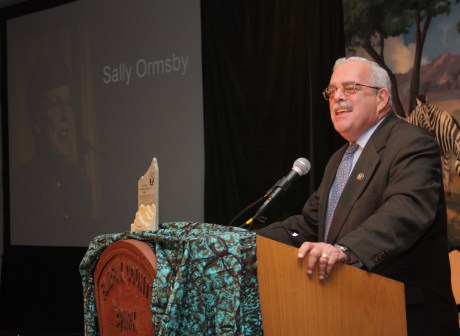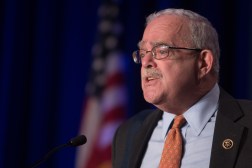4 takeaways from the latest FITARA Scorecard hearing

As the year ends and the 115th Congress soon comes to a close, agencies appear to finally be getting their arms around compliance with the Federal IT Acquisition Reform Act (FITARA) and other recent major IT legislation.
Rep. Will Hurd, R-Texas, hosted Wednesday what will likely go down as his last hearing chairing the House Oversight and Government Reform Committee’s IT Subcommittee — and aptly it was focused around the latest iteration of FITARA scorecard, which has now evolved into more of a digital hygiene scorecard. Results this time were positive, with the bulk of the 24 federal CFO Act agencies trending upward.
But that doesn’t mean there isn’t still work to be done, as Hurd said in his opening remarks. Lawmakers Wednesday homed in on both successes and shortcomings agencies have had around IT management and acquisition since the last hearing in May.
Here are the IT Subcommittee’s four key takeaways from the FITARA Scorecard 7.0:
HHS has become the model for FITARA success
Just a year ago, the Department of Health and Human Services received a D grade for its FITARA compliance. But in short order, HHS was able to bump that up to a B.
Acting CIO Ed Simcox said his team was able to do this by dedicating itself to the spirit and letter of the law through a program called “A by May,” in which it aimed to boost its FITARA scorecard to an A by May 2018. While it fell short of that goal, it still landed ahead of the rest of the pack in many places.
At HHS, Simcox said, “FITARA is both a law and a lifestyle.” And when asked what the secret sauce for HHS’s success is, he said, “it was our ability to institutionalize the FITARA framework inside of HHS and instill it in the culture at HHS and change the DNA — not only within our IT staff … but also in our leadership, getting a common dialogue and a common set of terminology that’s understood.”
Agencies made big strides in 2018 around software licensing
The category that weighed most on this particular scorecard was software licensing.
Eighteen agencies received an A grade specifically for software licensing this go-around, meaning they have a “comprehensive, regularly-updated inventory of software licenses” that are used to “make cost-effective decisions.” All other agencies failed, “although each of them had efforts underway to create and use an inventory,” the scorecard says. In May, just eight agencies scored an A for their licensing efforts.
Carol Harris, director of IT acquisition management issues for the Government Accountability Office, said there was $714 million in savings in 2018 from software license consolidation alone across the government. She also called HHS one of the best at it.
She gave compliments to Simcox for “instituting that greater adoption to break up these monolithic [software] projects into these smaller more manageable chunks … that’s where we avoid those disastrous, big bang-type major IT initiatives that ultimately fail.”
Harris also explained that the federal CIO Council is considering expanding the scope of incremental development to not just account for software development but “all IT projects,” meaning things like hardware or other larger projects that are part IT but also involve other elements.
Lawmakers aren’t happy with resistance to MGT Act working capital fund
However, one area HHS wasn’t successful with — and most other agencies weren’t, either — was setting up a working capital fund as created by the Modernizing Government Technology Act. Just one agency has set up a fund — the Department of Labor. The Department of Agriculture, Department of Homeland Security and the Small Business Administration plan to launch such a modernization fund managed by their CIOs by 2019 or 2020, according to the scorecard.
This was a point many lawmakers pressed on during the hearing. Hurd, in particular, dug into HHS for its claims that its non-recurring expense fund was an adequate substitute, despite the fact that the CIO didn’t have ultimate control over the fund to spend on modernization projects.
HHS CFO Sheila Conley also said for legal reasons, she can’t transfer money from that fund to an IT modernization working capital fund.
Hurd said that’s exactly the problem, and it’s why his committee began inviting other agency leaders, such as CFOs, to FITARA Scorecard hearings. “It’s other parts of the agencies getting in the way of letting the CIO do their jobs,” he said. “That’s why we’ve expanded these issues. That’s why I think it’s important for the reporting structure of the CIO to be at the deputy or agency head.”
Harris’ opinion is that it’s probably cultural resistance keeping agencies from setting up these funds. ”
“I think cultural change is really difficult,” she said. “So I think in large part, one of the reasons why agencies are not quick to embrace this MGT is a cultural issue versus a legal one.”
Data center optimization is still a struggle — and tracking it may get tougher
Another pain point in Wednesday’s hearing was data center optimization. Despite progress and savings of $4.5 billion since 2010, lawmakers criticized the slow pace some agencies are still taking consolidating their data centers in favor of the cloud.
Rep. Gerry Connolly, D-Va., said there’s “savings left on the table” because some agencies aren’t hitting their goals around data center optimization. There were five Fs and a D specifically in this category on the latest scorecard.
Harris agreed, “There’s still quite a bit of progress agencies can make.”
Connolly said he wants to “create pressure so that the default is ‘defend why you got it,'” referring to legacy, on-premise data centers.
But the Office Of Management and Budget is toying with the idea of changing how it measures data center optimization, which many lawmakers think could convolute Congress’ progress tracking progress around the goal.
OMB, as part of the recent Cloud Smart strategy, has proposed to change performance metrics to measure data center consolidation, now avoiding “using averages for metrics whenever possible or setting arbitrary goals, and will instead identify metrics where agencies can demonstrate continuous improvement beyond the performance period of this memorandum.”
Connolly said this will make it even harder to “compare apples to oranges” for consolidation. Harris agreed, saying the new metrics will “fuzzy up the waters.”






